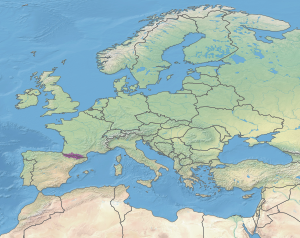Pyrenees conifer and mixed forests
The Pyrenees conifer and mixed forests is a temperate broadleaf and mixed forests ecoregion in southwestern Europe. It extends along the Pyrenees mountains which run east and west along the border between France and Spain, and includes all Andorra. The ecoregion extends from the lower slopes of the Pyrenees to its highest peaks, which include Aneto (3,404 m), Posets (3,375 m), and Vignemale (3,298 m).
| Pyrenees conifer and mixed forests | |
|---|---|
Pont d'Espagne waterfall near Cauterets, Hautes-Pyrénées, France | |
 Location of the Pyrenees conifer and mixed forests | |
| Ecology | |
| Realm | Palearctic |
| Biome | temperate broadleaf and mixed forests |
| Borders | List
|
| Geography | |
| Area | 25,931 km2 (10,012 sq mi) |
| Countries | Andorra, France and Spain |
| Autonomous communities of Spain | Aragon, Catalonia and Navarre |
| Conservation | |
| Conservation status | vulnerable |
| Global 200 | European-Mediterranean montane mixed forest |
| Protected | 3,863 km² (15%)[1] |
The Pyrenees forests are at the transition between the Mediterranean climate regions of Spain and France, which lie to the south and east, and the more humid and temperate forests of Western Europe, which lie to the west and north.[2]
Flora
The ecoregion's altitudinal range, and its various climatic regions (maritime temperate to the west, continental in the center, and Mediterranean to the east) support a variety of plant communities and species. The ecoregion has 3500 native plant species, including 200 endemic species.[2]
The forested foothills of the southern slope, known as the Pre-Pyrenees, have a transitional Mediterranean climate with dry summers. Characteristic trees include evergreen Holm oak (Quercus ilex) and deciduous Quercus faginea, Quercus pubescens, Tilia platyphyllos, and Acer opalus. Middle-elevation forests include deciduous broadleaf trees like Quercus petraea, Q. pubescens, and European beech (Fagus sylvatica), and conifer forests of Scots pine (Pinus sylvestris) and Pyrenean pine (Pinus nigra subsp. salzmannii var. salzmannii)[2]
High-elevation forests are predominantly of European beech and silver fir (Abies alba). Mountain pine (Pinus mugo subsp. uncinata) is common in continental-climate areas of the central Pyrenees with colder winters.[2]
Subalpine and alpine plant communities occur above the timberline, and include many endemic species.
Fauna
Large mammals include Eurasian brown bear (Ursus arctos), Iberian wolf (Canis lupus signatus), Pyrenean chamois (Rupicapra pyrenaica pyrenaica), wild boar (Sus scrofa), red deer (Cervus elaphus elaphus), and roe deer (Capreolus capreolus). The reclusive Pyrenean desman (Galemys pyrenaicus) is a vulnerable small mammal that lives here and in the Cantabrian Mountains.[3] The Pyrenean ibex (Capra pyrenaica pyrenaica) went extinct in 2000.[2]
The Cantabrian brown bear, a distinct southwest-European subspecies of Eurasian brown bear, is now extinct in the Pyrenees; the last Cantabrian brown bear was shot in 2004. The Cantabrian brown bear now survives further west in the Cantabrian Mountains.[4] Starting in 1996, the French government reintroduced Eurasian brown bears from Slovenia to the French Pyrenees.[5] As of 2019, there were 40 to 50 brown bears in the Pyrenees.[6]
The Pyrenees are home to 120 species of birds, including limited populations of lammergeier (Gypaetus barbatus), Pyrenean capercaillie (Tetrao urogallus aquitanicus) and rock ptarmigan (Lagopus muta).[2]
Protected areas
3,863 km2, or 10%, of the ecoregion is in protected areas. Only 1% of the unprotected area is still covered with natural forest.[1] Protected areas include Valles Occidentales Natural Park, Ordesa y Monte Perdido National Park, and Posets-Maladeta Natural Park in Aragon, Aigüestortes i Estany de Sant Maurici National Park, Alt Pirineu Natural Park, and Cadí-Moixeró Natural Park in Catalonia, and Pyrénées National Park, Pyrénées ariégeoises Regional Natural Park, and Pyrénées catalanes Regional Natural Park in France.
External links
| Wikimedia Commons has media related to Pyrenees conifer and mixed forests. |
- "Pyrenees conifer and mixed forests". Terrestrial Ecoregions. World Wildlife Fund.
References
- Eric Dinerstein, David Olson, et al. (2017). An Ecoregion-Based Approach to Protecting Half the Terrestrial Realm, BioScience, Volume 67, Issue 6, June 2017, Pages 534–545; Supplemental material 2 table S1b.
- "Pyrenees conifer and mixed forests". Terrestrial Ecoregions. World Wildlife Fund.
- "Cantabrian mixed forests". Terrestrial Ecoregions. World Wildlife Fund.
- Trinidad Pérez, Javier Naves, José Fernando Vázquez, Alberto Fernández-Gil, Juan Seijas, Jesús Albornoz, Eloy Revilla, Miguel Delibes, and Ana Domínguez "Estimating the population size of the endangered Cantabrian brown bear through genetic sampling," Wildlife Biology 20(5), 300-309, (1 October 2014). https://doi.org/10.2981/wlb.00069
- Zedrosser, Andreas, et al. “Status and Management of the Brown Bear in Europe.” Ursus, vol. 12, 2001, pp. 9–20. JSTOR, www.jstor.org/stable/3873224. Accessed 11 July 2020.
- Imbler, Sabrina (2019). "In the Pyrenees Mountains, It’s Bears vs. Sheep vs. Humans". Atlas Obscura, 3 September 2019. Accessed 11 July 2020.